Sports Marketing Report: NFL, Recycled Apparel, and Market Analysis
VerifiedAdded on 2023/06/05
|23
|5877
|169
Report
AI Summary
This report provides a comprehensive analysis of sports marketing strategies, focusing on the National Football League (NFL) and the use of recycled apparel. The report begins with an executive summary and an introduction that outlines the report's objectives. It then delves into an analysis of the NFL, including its history, market segmentation (demographic, psychographic, and behavioral profiles), and key messages to the target market. The report also examines the market factors, including the general market and three consumer segments: football coaches, football members, and the football audience under 70 years old. Furthermore, the report explores the use of recycled materials in apparel, detailing market segmentation, analysis of market factors, and key messages to the selected market, which is the football audience under 70. The report concludes with a summary of findings and references.

The Sports Marketing 0
Title: The Sports Marketing
Assignment Name:
Student Name:
Professor:
Date:
Title: The Sports Marketing
Assignment Name:
Student Name:
Professor:
Date:
Paraphrase This Document
Need a fresh take? Get an instant paraphrase of this document with our AI Paraphraser
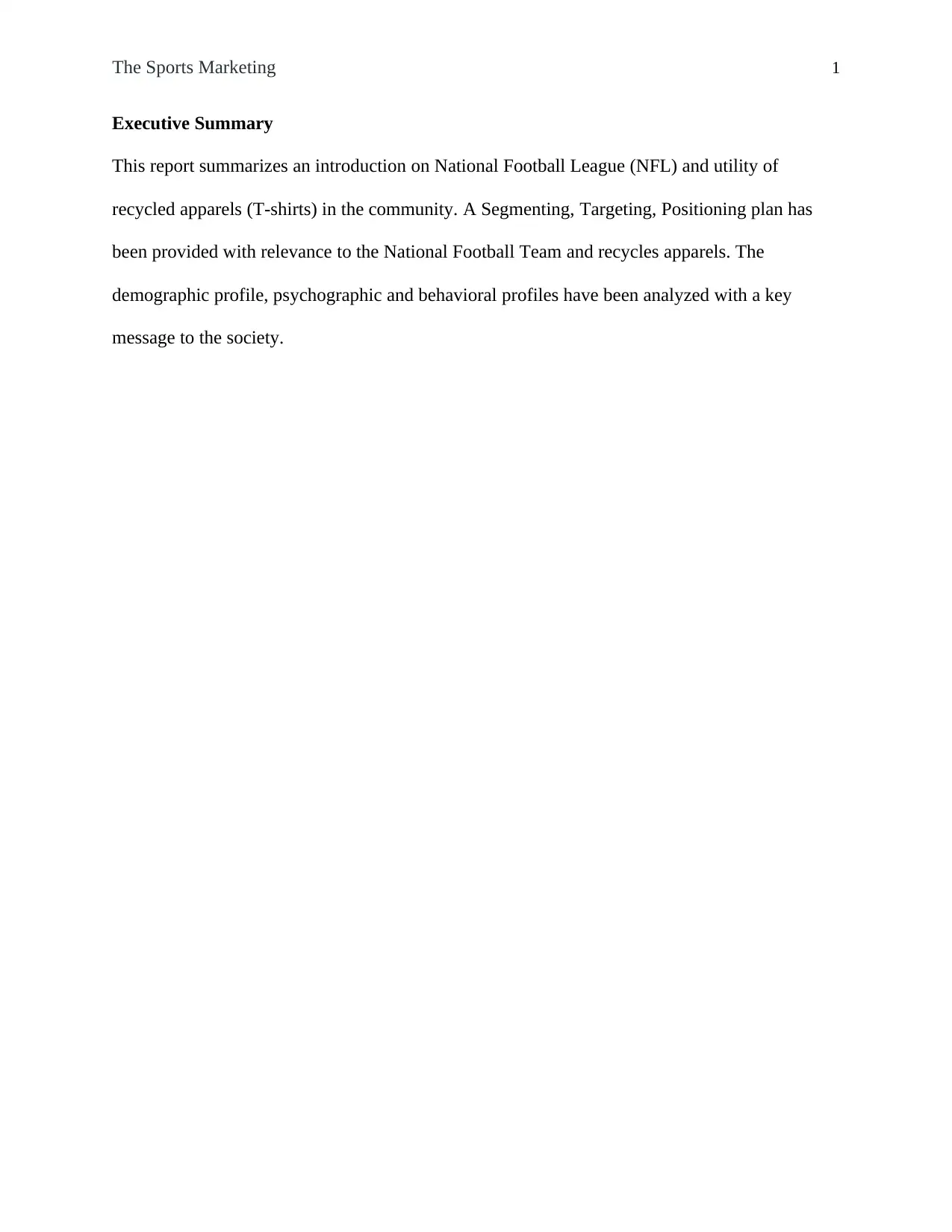
The Sports Marketing 1
Executive Summary
This report summarizes an introduction on National Football League (NFL) and utility of
recycled apparels (T-shirts) in the community. A Segmenting, Targeting, Positioning plan has
been provided with relevance to the National Football Team and recycles apparels. The
demographic profile, psychographic and behavioral profiles have been analyzed with a key
message to the society.
Executive Summary
This report summarizes an introduction on National Football League (NFL) and utility of
recycled apparels (T-shirts) in the community. A Segmenting, Targeting, Positioning plan has
been provided with relevance to the National Football Team and recycles apparels. The
demographic profile, psychographic and behavioral profiles have been analyzed with a key
message to the society.

The Sports Marketing 2
Contents
Introduction......................................................................................................................................3
A. NFL Analysis........................................................................................................................3
1. Market Segmentation......................................................................................................................5
2. Analysis of Market Factors...............................................................................................................6
3. Key Messages to Selected Market...................................................................................................8
B. Apparel Composed of Recycled Materials...........................................................................9
1. Market Segmentation....................................................................................................................13
2. Analysis of Market Factors.............................................................................................................14
3. Key Messages to Selected Market.................................................................................................16
Conclusion.....................................................................................................................................17
References......................................................................................................................................19
Introduction
Contents
Introduction......................................................................................................................................3
A. NFL Analysis........................................................................................................................3
1. Market Segmentation......................................................................................................................5
2. Analysis of Market Factors...............................................................................................................6
3. Key Messages to Selected Market...................................................................................................8
B. Apparel Composed of Recycled Materials...........................................................................9
1. Market Segmentation....................................................................................................................13
2. Analysis of Market Factors.............................................................................................................14
3. Key Messages to Selected Market.................................................................................................16
Conclusion.....................................................................................................................................17
References......................................................................................................................................19
Introduction
⊘ This is a preview!⊘
Do you want full access?
Subscribe today to unlock all pages.

Trusted by 1+ million students worldwide
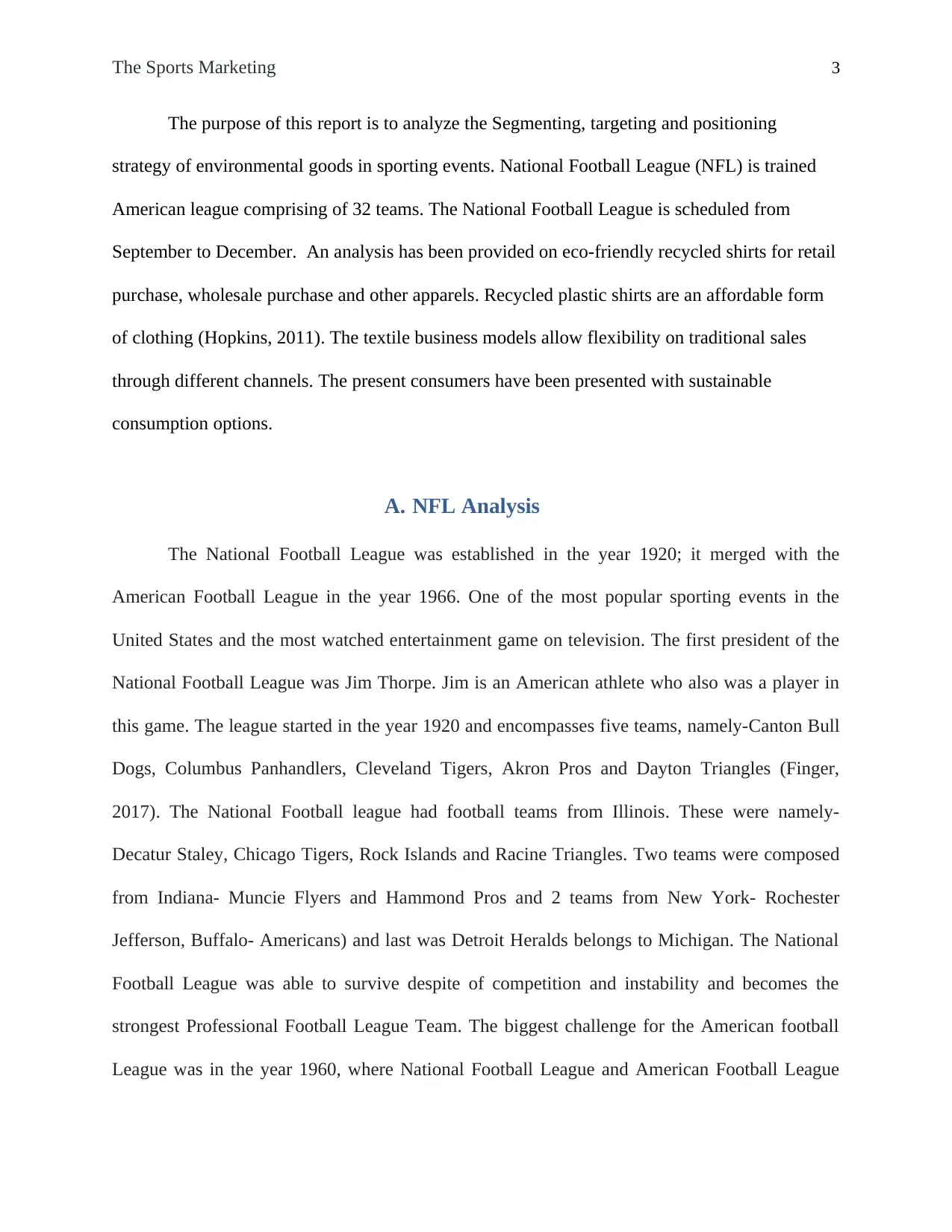
The Sports Marketing 3
The purpose of this report is to analyze the Segmenting, targeting and positioning
strategy of environmental goods in sporting events. National Football League (NFL) is trained
American league comprising of 32 teams. The National Football League is scheduled from
September to December. An analysis has been provided on eco-friendly recycled shirts for retail
purchase, wholesale purchase and other apparels. Recycled plastic shirts are an affordable form
of clothing (Hopkins, 2011). The textile business models allow flexibility on traditional sales
through different channels. The present consumers have been presented with sustainable
consumption options.
A. NFL Analysis
The National Football League was established in the year 1920; it merged with the
American Football League in the year 1966. One of the most popular sporting events in the
United States and the most watched entertainment game on television. The first president of the
National Football League was Jim Thorpe. Jim is an American athlete who also was a player in
this game. The league started in the year 1920 and encompasses five teams, namely-Canton Bull
Dogs, Columbus Panhandlers, Cleveland Tigers, Akron Pros and Dayton Triangles (Finger,
2017). The National Football league had football teams from Illinois. These were namely-
Decatur Staley, Chicago Tigers, Rock Islands and Racine Triangles. Two teams were composed
from Indiana- Muncie Flyers and Hammond Pros and 2 teams from New York- Rochester
Jefferson, Buffalo- Americans) and last was Detroit Heralds belongs to Michigan. The National
Football League was able to survive despite of competition and instability and becomes the
strongest Professional Football League Team. The biggest challenge for the American football
League was in the year 1960, where National Football League and American Football League
The purpose of this report is to analyze the Segmenting, targeting and positioning
strategy of environmental goods in sporting events. National Football League (NFL) is trained
American league comprising of 32 teams. The National Football League is scheduled from
September to December. An analysis has been provided on eco-friendly recycled shirts for retail
purchase, wholesale purchase and other apparels. Recycled plastic shirts are an affordable form
of clothing (Hopkins, 2011). The textile business models allow flexibility on traditional sales
through different channels. The present consumers have been presented with sustainable
consumption options.
A. NFL Analysis
The National Football League was established in the year 1920; it merged with the
American Football League in the year 1966. One of the most popular sporting events in the
United States and the most watched entertainment game on television. The first president of the
National Football League was Jim Thorpe. Jim is an American athlete who also was a player in
this game. The league started in the year 1920 and encompasses five teams, namely-Canton Bull
Dogs, Columbus Panhandlers, Cleveland Tigers, Akron Pros and Dayton Triangles (Finger,
2017). The National Football league had football teams from Illinois. These were namely-
Decatur Staley, Chicago Tigers, Rock Islands and Racine Triangles. Two teams were composed
from Indiana- Muncie Flyers and Hammond Pros and 2 teams from New York- Rochester
Jefferson, Buffalo- Americans) and last was Detroit Heralds belongs to Michigan. The National
Football League was able to survive despite of competition and instability and becomes the
strongest Professional Football League Team. The biggest challenge for the American football
League was in the year 1960, where National Football League and American Football League
Paraphrase This Document
Need a fresh take? Get an instant paraphrase of this document with our AI Paraphraser

The Sports Marketing 4
completed the merger in the year 1970. The National Football League has formed 25 team
member circuit under its name of old NFL. The National Football League has expanded 4 times
and has added 6 new franchisee to its credentials. The National Football League season starts
with an annual twelve team players and leading to a Super Bowl game. The NFL has created
dual mission- “Caring for own” and Caring for the Kids” (Kelly, 2006). NFL alumni work for all
the existing players and engage them to service towards the community, through raising funds.
NFL members have been organized into the forms of different chapters and its fundraising
efforts are outstanding. The National Football League coaches and alumni provide a unique
experience to the players and families. In order to enhance associations with present and existing
players at different regional levels, the NFL has trained sixteen NFL coaches and has been
providing guidance as required, to families, transition and crisis. The National Football League
tickets are easily sold off. The youngsters show massive interest in attending the tournament. The
masses can purchase the football league day tournament tickets at US$ 100 TO US$130. There
are no approximate reports on the number of persons attending the event, but more than 50,000
people attend the football league (Fitzgerald and Jensen, 2018).
The Walter NFLMAN Payton of the year award has been presented nationwide and
established in the year 1970. This award recognizes the players for their outstanding excellence
and it is one of the prestigious awards. Every team is required to nominate one player who would
win the national award. The NFL players association honors veterans and military members and
families offer salute campaigns. These efforts end in November along with special games and
events, honoring the players and family members, active members and veterans. The National
Football League and club associates work together for the tragedy assistance programs and
completed the merger in the year 1970. The National Football League has formed 25 team
member circuit under its name of old NFL. The National Football League has expanded 4 times
and has added 6 new franchisee to its credentials. The National Football League season starts
with an annual twelve team players and leading to a Super Bowl game. The NFL has created
dual mission- “Caring for own” and Caring for the Kids” (Kelly, 2006). NFL alumni work for all
the existing players and engage them to service towards the community, through raising funds.
NFL members have been organized into the forms of different chapters and its fundraising
efforts are outstanding. The National Football League coaches and alumni provide a unique
experience to the players and families. In order to enhance associations with present and existing
players at different regional levels, the NFL has trained sixteen NFL coaches and has been
providing guidance as required, to families, transition and crisis. The National Football League
tickets are easily sold off. The youngsters show massive interest in attending the tournament. The
masses can purchase the football league day tournament tickets at US$ 100 TO US$130. There
are no approximate reports on the number of persons attending the event, but more than 50,000
people attend the football league (Fitzgerald and Jensen, 2018).
The Walter NFLMAN Payton of the year award has been presented nationwide and
established in the year 1970. This award recognizes the players for their outstanding excellence
and it is one of the prestigious awards. Every team is required to nominate one player who would
win the national award. The NFL players association honors veterans and military members and
families offer salute campaigns. These efforts end in November along with special games and
events, honoring the players and family members, active members and veterans. The National
Football League and club associates work together for the tragedy assistance programs and
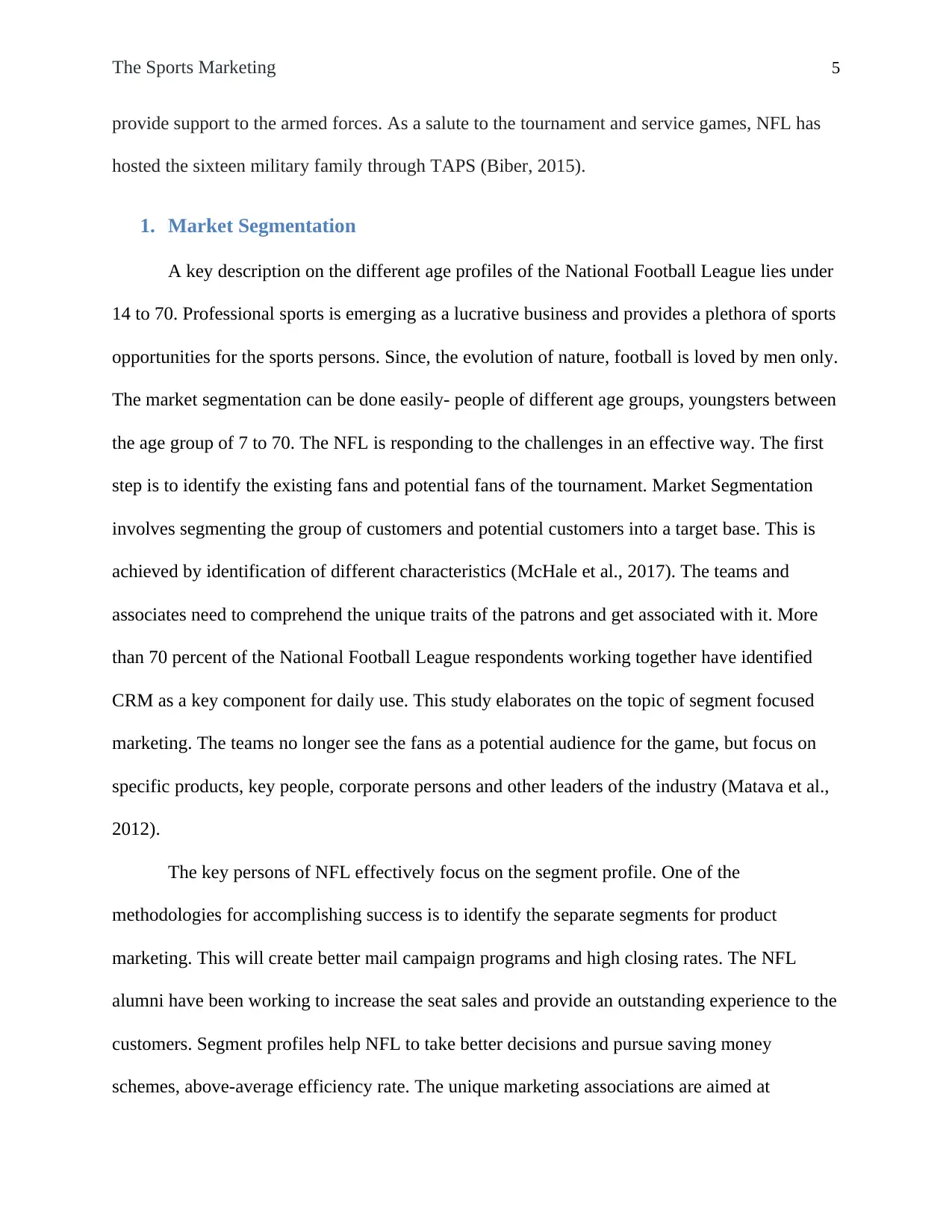
The Sports Marketing 5
provide support to the armed forces. As a salute to the tournament and service games, NFL has
hosted the sixteen military family through TAPS (Biber, 2015).
1. Market Segmentation
A key description on the different age profiles of the National Football League lies under
14 to 70. Professional sports is emerging as a lucrative business and provides a plethora of sports
opportunities for the sports persons. Since, the evolution of nature, football is loved by men only.
The market segmentation can be done easily- people of different age groups, youngsters between
the age group of 7 to 70. The NFL is responding to the challenges in an effective way. The first
step is to identify the existing fans and potential fans of the tournament. Market Segmentation
involves segmenting the group of customers and potential customers into a target base. This is
achieved by identification of different characteristics (McHale et al., 2017). The teams and
associates need to comprehend the unique traits of the patrons and get associated with it. More
than 70 percent of the National Football League respondents working together have identified
CRM as a key component for daily use. This study elaborates on the topic of segment focused
marketing. The teams no longer see the fans as a potential audience for the game, but focus on
specific products, key people, corporate persons and other leaders of the industry (Matava et al.,
2012).
The key persons of NFL effectively focus on the segment profile. One of the
methodologies for accomplishing success is to identify the separate segments for product
marketing. This will create better mail campaign programs and high closing rates. The NFL
alumni have been working to increase the seat sales and provide an outstanding experience to the
customers. Segment profiles help NFL to take better decisions and pursue saving money
schemes, above-average efficiency rate. The unique marketing associations are aimed at
provide support to the armed forces. As a salute to the tournament and service games, NFL has
hosted the sixteen military family through TAPS (Biber, 2015).
1. Market Segmentation
A key description on the different age profiles of the National Football League lies under
14 to 70. Professional sports is emerging as a lucrative business and provides a plethora of sports
opportunities for the sports persons. Since, the evolution of nature, football is loved by men only.
The market segmentation can be done easily- people of different age groups, youngsters between
the age group of 7 to 70. The NFL is responding to the challenges in an effective way. The first
step is to identify the existing fans and potential fans of the tournament. Market Segmentation
involves segmenting the group of customers and potential customers into a target base. This is
achieved by identification of different characteristics (McHale et al., 2017). The teams and
associates need to comprehend the unique traits of the patrons and get associated with it. More
than 70 percent of the National Football League respondents working together have identified
CRM as a key component for daily use. This study elaborates on the topic of segment focused
marketing. The teams no longer see the fans as a potential audience for the game, but focus on
specific products, key people, corporate persons and other leaders of the industry (Matava et al.,
2012).
The key persons of NFL effectively focus on the segment profile. One of the
methodologies for accomplishing success is to identify the separate segments for product
marketing. This will create better mail campaign programs and high closing rates. The NFL
alumni have been working to increase the seat sales and provide an outstanding experience to the
customers. Segment profiles help NFL to take better decisions and pursue saving money
schemes, above-average efficiency rate. The unique marketing associations are aimed at
⊘ This is a preview!⊘
Do you want full access?
Subscribe today to unlock all pages.

Trusted by 1+ million students worldwide

The Sports Marketing 6
identification of unique traits and characteristics of current buyers. The utilization of the same
information for segmenting the customer profiles and formulating the marketing efforts (Davies
and Dunbar, 2015).
The NFL interactive marketing efforts are aimed at learning the possible outcomes on an
audience behavior. Creation of a new database structure for modeling the new leads through that
information. Database segmentation benefits sponsorship teams and offer opportunities to
potential partners. The association partners create win-win situation for both the teams.
Leveraging the existing asset and tapping into new categories is possible through the interactive
marketing schemes of the NFL. The National Football League receives the increased revenue
and more companies are associated with it. This has a direct access to customer subset. The
members of the military target customer segments. This is achieved through innovation and
technology companies and get opportunity to involve with military focused categories. The
National Football League has opened new categories for sponsorships and companies are
effectively relevant to a given market segment. The NFL delivers new players with associations
to alumni and provide training. Market segmentation enables NFL to operate more effectively
and tap new opportunities. The National Football League efforts are aimed at increasing the
revenue. Market Segmentation is the cost-effective way of identification of assets and increasing
the existing customer base within the environment. The National Football League understands
the power of target segment (Einolf, 2004).
2. Analysis of Market Factors
a) General Market
identification of unique traits and characteristics of current buyers. The utilization of the same
information for segmenting the customer profiles and formulating the marketing efforts (Davies
and Dunbar, 2015).
The NFL interactive marketing efforts are aimed at learning the possible outcomes on an
audience behavior. Creation of a new database structure for modeling the new leads through that
information. Database segmentation benefits sponsorship teams and offer opportunities to
potential partners. The association partners create win-win situation for both the teams.
Leveraging the existing asset and tapping into new categories is possible through the interactive
marketing schemes of the NFL. The National Football League receives the increased revenue
and more companies are associated with it. This has a direct access to customer subset. The
members of the military target customer segments. This is achieved through innovation and
technology companies and get opportunity to involve with military focused categories. The
National Football League has opened new categories for sponsorships and companies are
effectively relevant to a given market segment. The NFL delivers new players with associations
to alumni and provide training. Market segmentation enables NFL to operate more effectively
and tap new opportunities. The National Football League efforts are aimed at increasing the
revenue. Market Segmentation is the cost-effective way of identification of assets and increasing
the existing customer base within the environment. The National Football League understands
the power of target segment (Einolf, 2004).
2. Analysis of Market Factors
a) General Market
Paraphrase This Document
Need a fresh take? Get an instant paraphrase of this document with our AI Paraphraser
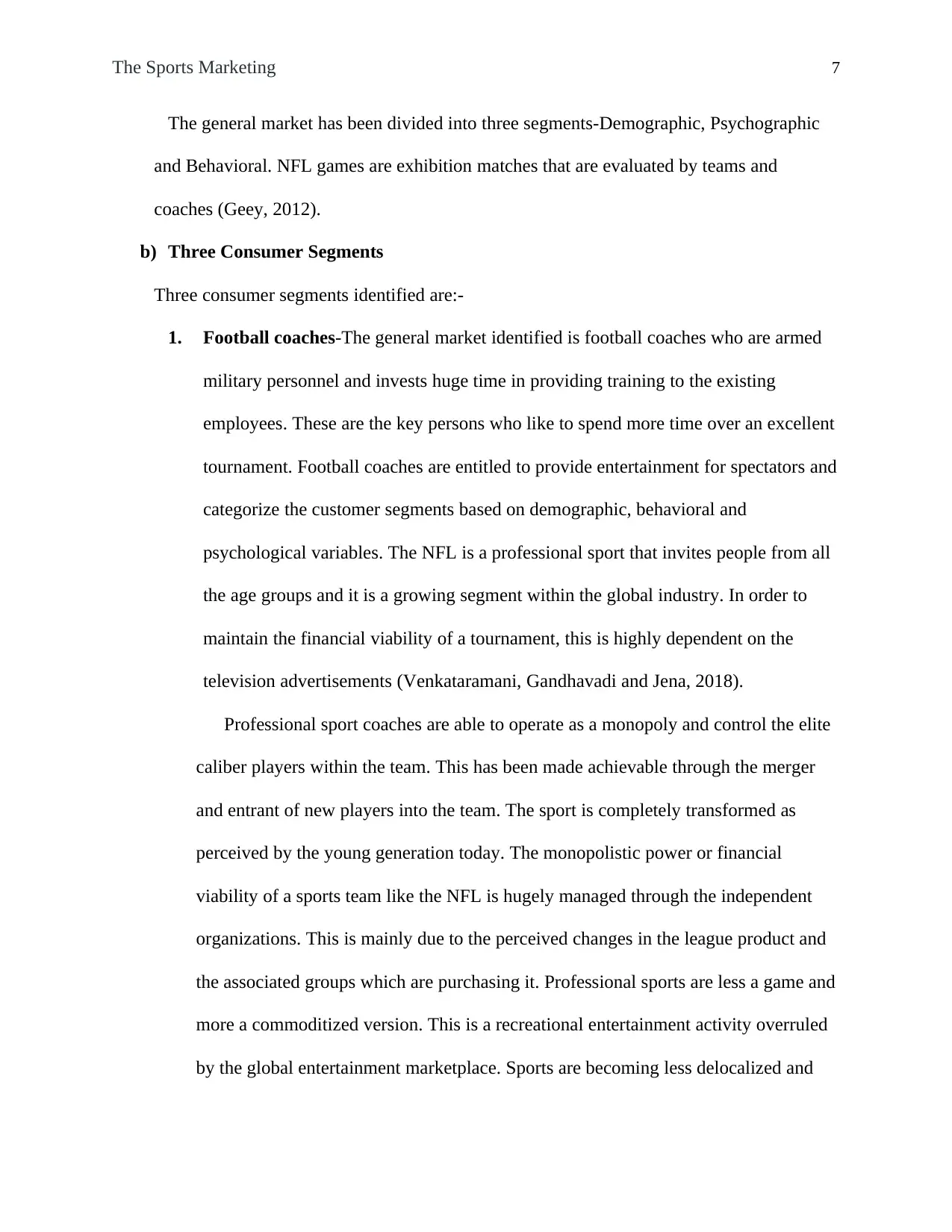
The Sports Marketing 7
The general market has been divided into three segments-Demographic, Psychographic
and Behavioral. NFL games are exhibition matches that are evaluated by teams and
coaches (Geey, 2012).
b) Three Consumer Segments
Three consumer segments identified are:-
1. Football coaches-The general market identified is football coaches who are armed
military personnel and invests huge time in providing training to the existing
employees. These are the key persons who like to spend more time over an excellent
tournament. Football coaches are entitled to provide entertainment for spectators and
categorize the customer segments based on demographic, behavioral and
psychological variables. The NFL is a professional sport that invites people from all
the age groups and it is a growing segment within the global industry. In order to
maintain the financial viability of a tournament, this is highly dependent on the
television advertisements (Venkataramani, Gandhavadi and Jena, 2018).
Professional sport coaches are able to operate as a monopoly and control the elite
caliber players within the team. This has been made achievable through the merger
and entrant of new players into the team. The sport is completely transformed as
perceived by the young generation today. The monopolistic power or financial
viability of a sports team like the NFL is hugely managed through the independent
organizations. This is mainly due to the perceived changes in the league product and
the associated groups which are purchasing it. Professional sports are less a game and
more a commoditized version. This is a recreational entertainment activity overruled
by the global entertainment marketplace. Sports are becoming less delocalized and
The general market has been divided into three segments-Demographic, Psychographic
and Behavioral. NFL games are exhibition matches that are evaluated by teams and
coaches (Geey, 2012).
b) Three Consumer Segments
Three consumer segments identified are:-
1. Football coaches-The general market identified is football coaches who are armed
military personnel and invests huge time in providing training to the existing
employees. These are the key persons who like to spend more time over an excellent
tournament. Football coaches are entitled to provide entertainment for spectators and
categorize the customer segments based on demographic, behavioral and
psychological variables. The NFL is a professional sport that invites people from all
the age groups and it is a growing segment within the global industry. In order to
maintain the financial viability of a tournament, this is highly dependent on the
television advertisements (Venkataramani, Gandhavadi and Jena, 2018).
Professional sport coaches are able to operate as a monopoly and control the elite
caliber players within the team. This has been made achievable through the merger
and entrant of new players into the team. The sport is completely transformed as
perceived by the young generation today. The monopolistic power or financial
viability of a sports team like the NFL is hugely managed through the independent
organizations. This is mainly due to the perceived changes in the league product and
the associated groups which are purchasing it. Professional sports are less a game and
more a commoditized version. This is a recreational entertainment activity overruled
by the global entertainment marketplace. Sports are becoming less delocalized and
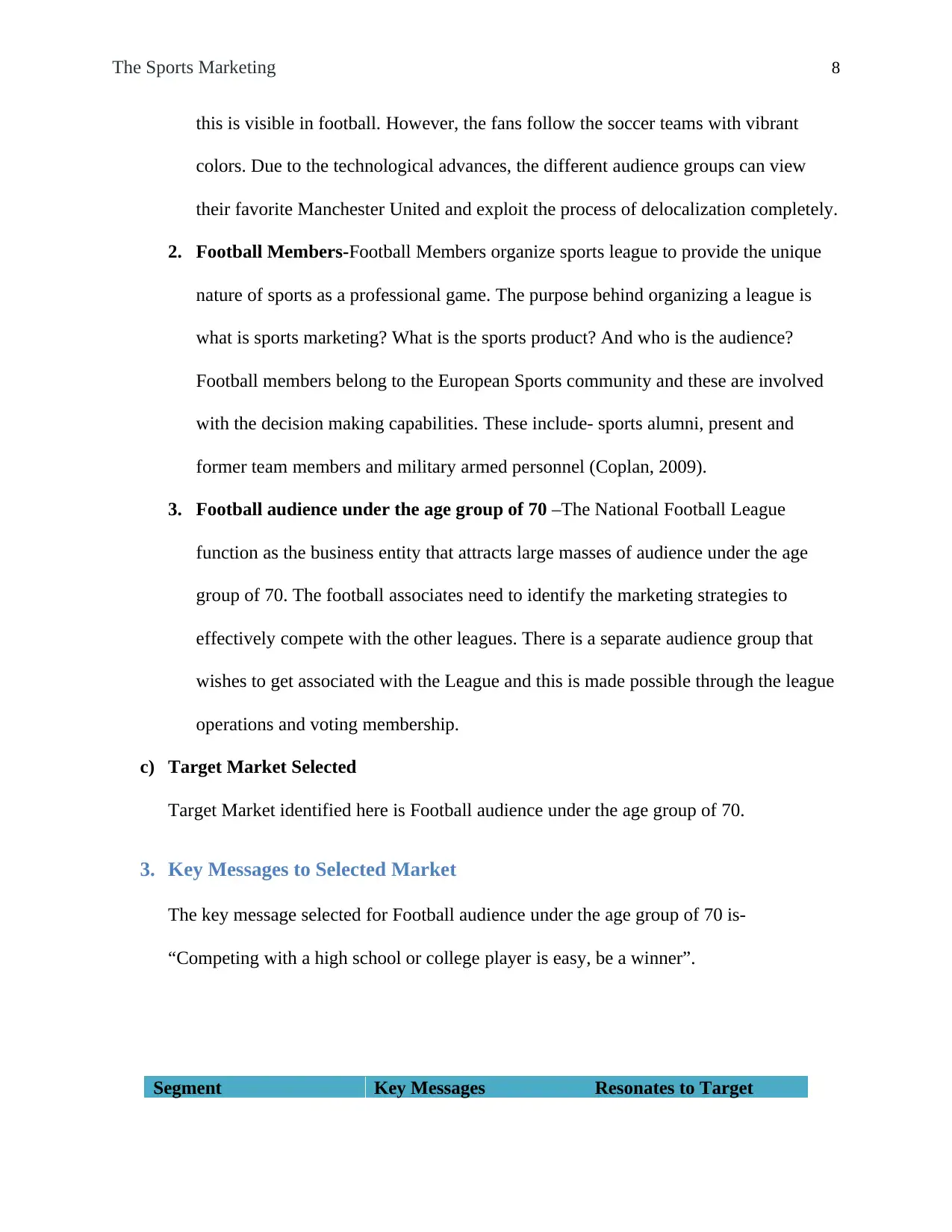
The Sports Marketing 8
this is visible in football. However, the fans follow the soccer teams with vibrant
colors. Due to the technological advances, the different audience groups can view
their favorite Manchester United and exploit the process of delocalization completely.
2. Football Members-Football Members organize sports league to provide the unique
nature of sports as a professional game. The purpose behind organizing a league is
what is sports marketing? What is the sports product? And who is the audience?
Football members belong to the European Sports community and these are involved
with the decision making capabilities. These include- sports alumni, present and
former team members and military armed personnel (Coplan, 2009).
3. Football audience under the age group of 70 –The National Football League
function as the business entity that attracts large masses of audience under the age
group of 70. The football associates need to identify the marketing strategies to
effectively compete with the other leagues. There is a separate audience group that
wishes to get associated with the League and this is made possible through the league
operations and voting membership.
c) Target Market Selected
Target Market identified here is Football audience under the age group of 70.
3. Key Messages to Selected Market
The key message selected for Football audience under the age group of 70 is-
“Competing with a high school or college player is easy, be a winner”.
Segment Key Messages Resonates to Target
this is visible in football. However, the fans follow the soccer teams with vibrant
colors. Due to the technological advances, the different audience groups can view
their favorite Manchester United and exploit the process of delocalization completely.
2. Football Members-Football Members organize sports league to provide the unique
nature of sports as a professional game. The purpose behind organizing a league is
what is sports marketing? What is the sports product? And who is the audience?
Football members belong to the European Sports community and these are involved
with the decision making capabilities. These include- sports alumni, present and
former team members and military armed personnel (Coplan, 2009).
3. Football audience under the age group of 70 –The National Football League
function as the business entity that attracts large masses of audience under the age
group of 70. The football associates need to identify the marketing strategies to
effectively compete with the other leagues. There is a separate audience group that
wishes to get associated with the League and this is made possible through the league
operations and voting membership.
c) Target Market Selected
Target Market identified here is Football audience under the age group of 70.
3. Key Messages to Selected Market
The key message selected for Football audience under the age group of 70 is-
“Competing with a high school or college player is easy, be a winner”.
Segment Key Messages Resonates to Target
⊘ This is a preview!⊘
Do you want full access?
Subscribe today to unlock all pages.

Trusted by 1+ million students worldwide
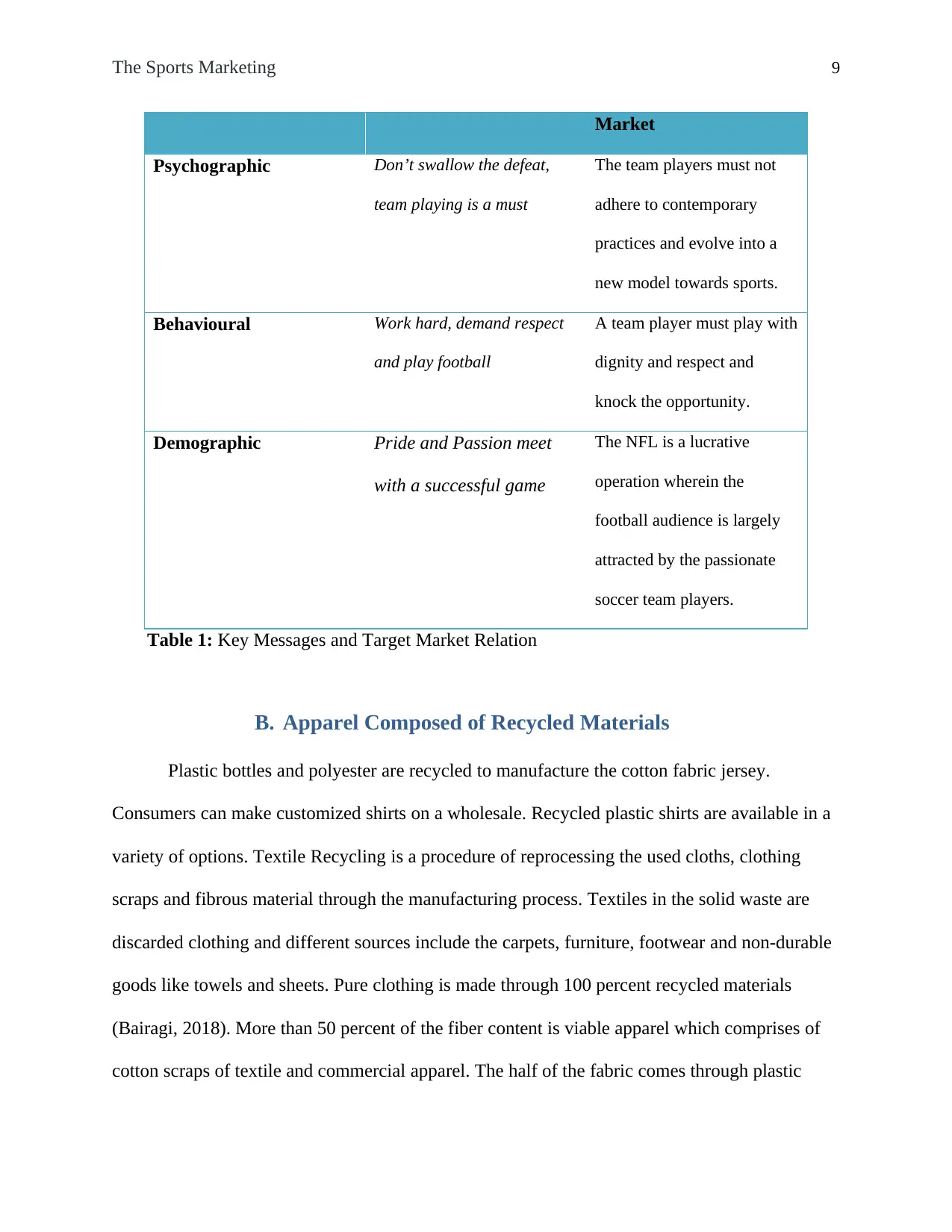
The Sports Marketing 9
Market
Psychographic Don’t swallow the defeat,
team playing is a must
The team players must not
adhere to contemporary
practices and evolve into a
new model towards sports.
Behavioural Work hard, demand respect
and play football
A team player must play with
dignity and respect and
knock the opportunity.
Demographic Pride and Passion meet
with a successful game
The NFL is a lucrative
operation wherein the
football audience is largely
attracted by the passionate
soccer team players.
Table 1: Key Messages and Target Market Relation
B. Apparel Composed of Recycled Materials
Plastic bottles and polyester are recycled to manufacture the cotton fabric jersey.
Consumers can make customized shirts on a wholesale. Recycled plastic shirts are available in a
variety of options. Textile Recycling is a procedure of reprocessing the used cloths, clothing
scraps and fibrous material through the manufacturing process. Textiles in the solid waste are
discarded clothing and different sources include the carpets, furniture, footwear and non-durable
goods like towels and sheets. Pure clothing is made through 100 percent recycled materials
(Bairagi, 2018). More than 50 percent of the fiber content is viable apparel which comprises of
cotton scraps of textile and commercial apparel. The half of the fabric comes through plastic
Market
Psychographic Don’t swallow the defeat,
team playing is a must
The team players must not
adhere to contemporary
practices and evolve into a
new model towards sports.
Behavioural Work hard, demand respect
and play football
A team player must play with
dignity and respect and
knock the opportunity.
Demographic Pride and Passion meet
with a successful game
The NFL is a lucrative
operation wherein the
football audience is largely
attracted by the passionate
soccer team players.
Table 1: Key Messages and Target Market Relation
B. Apparel Composed of Recycled Materials
Plastic bottles and polyester are recycled to manufacture the cotton fabric jersey.
Consumers can make customized shirts on a wholesale. Recycled plastic shirts are available in a
variety of options. Textile Recycling is a procedure of reprocessing the used cloths, clothing
scraps and fibrous material through the manufacturing process. Textiles in the solid waste are
discarded clothing and different sources include the carpets, furniture, footwear and non-durable
goods like towels and sheets. Pure clothing is made through 100 percent recycled materials
(Bairagi, 2018). More than 50 percent of the fiber content is viable apparel which comprises of
cotton scraps of textile and commercial apparel. The half of the fabric comes through plastic
Paraphrase This Document
Need a fresh take? Get an instant paraphrase of this document with our AI Paraphraser
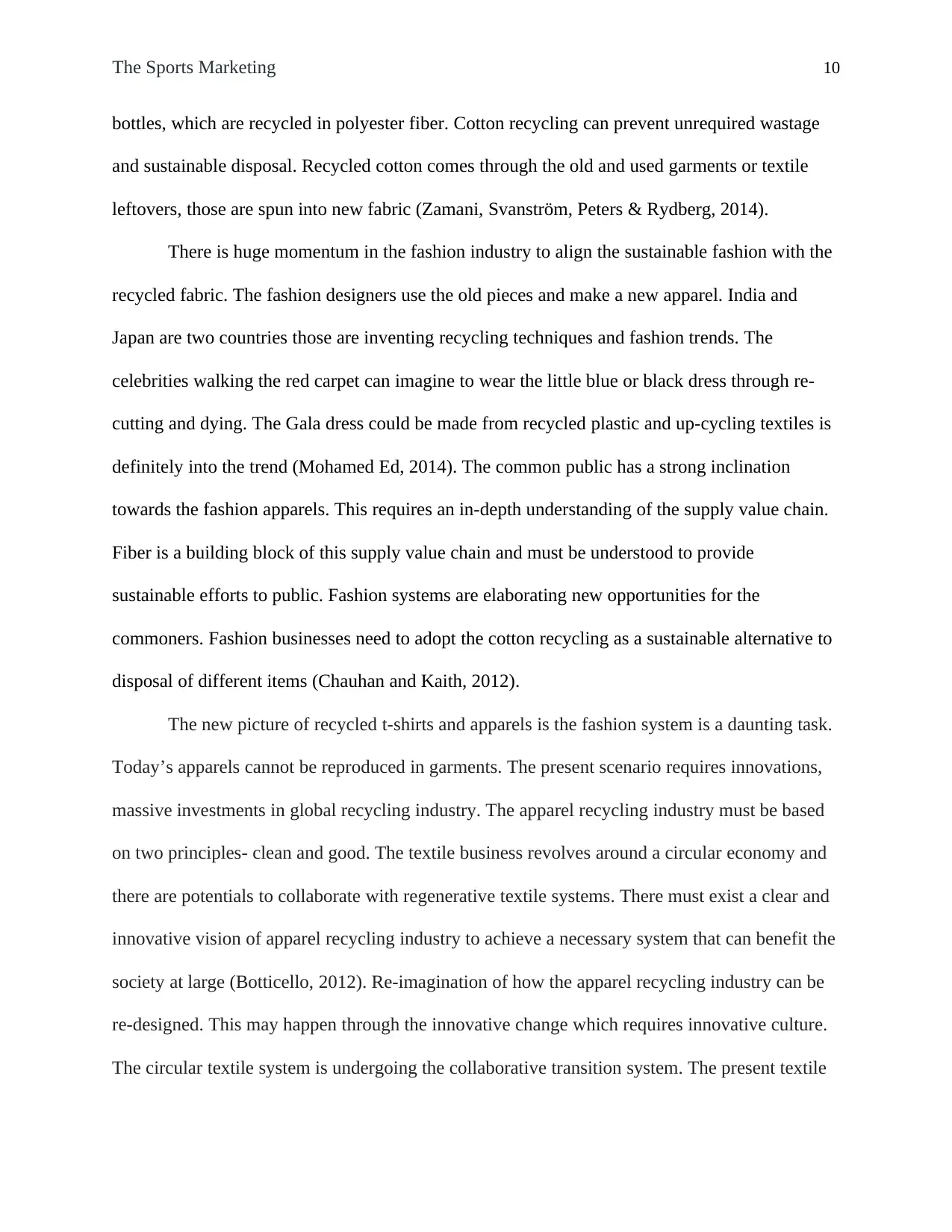
The Sports Marketing 10
bottles, which are recycled in polyester fiber. Cotton recycling can prevent unrequired wastage
and sustainable disposal. Recycled cotton comes through the old and used garments or textile
leftovers, those are spun into new fabric (Zamani, Svanström, Peters & Rydberg, 2014).
There is huge momentum in the fashion industry to align the sustainable fashion with the
recycled fabric. The fashion designers use the old pieces and make a new apparel. India and
Japan are two countries those are inventing recycling techniques and fashion trends. The
celebrities walking the red carpet can imagine to wear the little blue or black dress through re-
cutting and dying. The Gala dress could be made from recycled plastic and up-cycling textiles is
definitely into the trend (Mohamed Ed, 2014). The common public has a strong inclination
towards the fashion apparels. This requires an in-depth understanding of the supply value chain.
Fiber is a building block of this supply value chain and must be understood to provide
sustainable efforts to public. Fashion systems are elaborating new opportunities for the
commoners. Fashion businesses need to adopt the cotton recycling as a sustainable alternative to
disposal of different items (Chauhan and Kaith, 2012).
The new picture of recycled t-shirts and apparels is the fashion system is a daunting task.
Today’s apparels cannot be reproduced in garments. The present scenario requires innovations,
massive investments in global recycling industry. The apparel recycling industry must be based
on two principles- clean and good. The textile business revolves around a circular economy and
there are potentials to collaborate with regenerative textile systems. There must exist a clear and
innovative vision of apparel recycling industry to achieve a necessary system that can benefit the
society at large (Botticello, 2012). Re-imagination of how the apparel recycling industry can be
re-designed. This may happen through the innovative change which requires innovative culture.
The circular textile system is undergoing the collaborative transition system. The present textile
bottles, which are recycled in polyester fiber. Cotton recycling can prevent unrequired wastage
and sustainable disposal. Recycled cotton comes through the old and used garments or textile
leftovers, those are spun into new fabric (Zamani, Svanström, Peters & Rydberg, 2014).
There is huge momentum in the fashion industry to align the sustainable fashion with the
recycled fabric. The fashion designers use the old pieces and make a new apparel. India and
Japan are two countries those are inventing recycling techniques and fashion trends. The
celebrities walking the red carpet can imagine to wear the little blue or black dress through re-
cutting and dying. The Gala dress could be made from recycled plastic and up-cycling textiles is
definitely into the trend (Mohamed Ed, 2014). The common public has a strong inclination
towards the fashion apparels. This requires an in-depth understanding of the supply value chain.
Fiber is a building block of this supply value chain and must be understood to provide
sustainable efforts to public. Fashion systems are elaborating new opportunities for the
commoners. Fashion businesses need to adopt the cotton recycling as a sustainable alternative to
disposal of different items (Chauhan and Kaith, 2012).
The new picture of recycled t-shirts and apparels is the fashion system is a daunting task.
Today’s apparels cannot be reproduced in garments. The present scenario requires innovations,
massive investments in global recycling industry. The apparel recycling industry must be based
on two principles- clean and good. The textile business revolves around a circular economy and
there are potentials to collaborate with regenerative textile systems. There must exist a clear and
innovative vision of apparel recycling industry to achieve a necessary system that can benefit the
society at large (Botticello, 2012). Re-imagination of how the apparel recycling industry can be
re-designed. This may happen through the innovative change which requires innovative culture.
The circular textile system is undergoing the collaborative transition system. The present textile
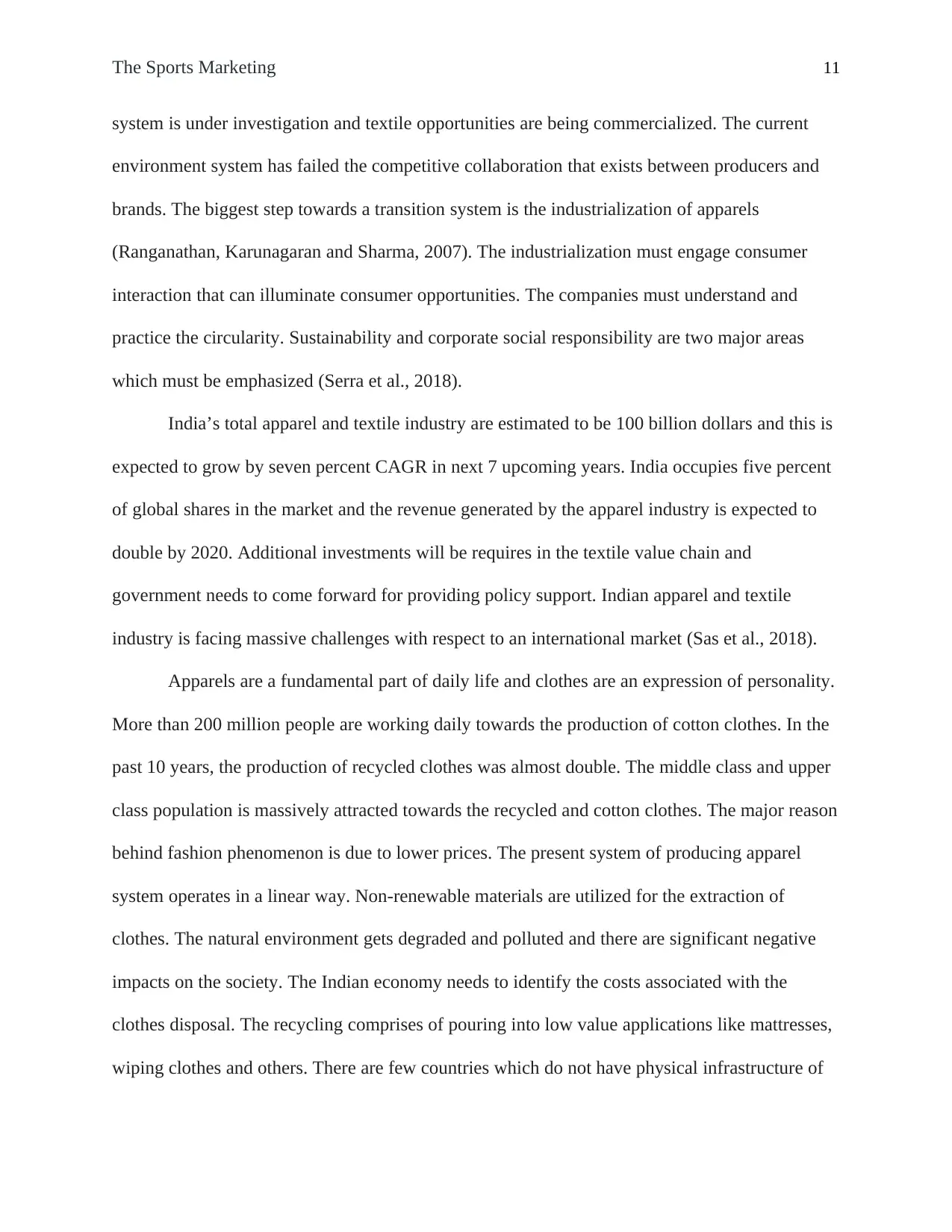
The Sports Marketing 11
system is under investigation and textile opportunities are being commercialized. The current
environment system has failed the competitive collaboration that exists between producers and
brands. The biggest step towards a transition system is the industrialization of apparels
(Ranganathan, Karunagaran and Sharma, 2007). The industrialization must engage consumer
interaction that can illuminate consumer opportunities. The companies must understand and
practice the circularity. Sustainability and corporate social responsibility are two major areas
which must be emphasized (Serra et al., 2018).
India’s total apparel and textile industry are estimated to be 100 billion dollars and this is
expected to grow by seven percent CAGR in next 7 upcoming years. India occupies five percent
of global shares in the market and the revenue generated by the apparel industry is expected to
double by 2020. Additional investments will be requires in the textile value chain and
government needs to come forward for providing policy support. Indian apparel and textile
industry is facing massive challenges with respect to an international market (Sas et al., 2018).
Apparels are a fundamental part of daily life and clothes are an expression of personality.
More than 200 million people are working daily towards the production of cotton clothes. In the
past 10 years, the production of recycled clothes was almost double. The middle class and upper
class population is massively attracted towards the recycled and cotton clothes. The major reason
behind fashion phenomenon is due to lower prices. The present system of producing apparel
system operates in a linear way. Non-renewable materials are utilized for the extraction of
clothes. The natural environment gets degraded and polluted and there are significant negative
impacts on the society. The Indian economy needs to identify the costs associated with the
clothes disposal. The recycling comprises of pouring into low value applications like mattresses,
wiping clothes and others. There are few countries which do not have physical infrastructure of
system is under investigation and textile opportunities are being commercialized. The current
environment system has failed the competitive collaboration that exists between producers and
brands. The biggest step towards a transition system is the industrialization of apparels
(Ranganathan, Karunagaran and Sharma, 2007). The industrialization must engage consumer
interaction that can illuminate consumer opportunities. The companies must understand and
practice the circularity. Sustainability and corporate social responsibility are two major areas
which must be emphasized (Serra et al., 2018).
India’s total apparel and textile industry are estimated to be 100 billion dollars and this is
expected to grow by seven percent CAGR in next 7 upcoming years. India occupies five percent
of global shares in the market and the revenue generated by the apparel industry is expected to
double by 2020. Additional investments will be requires in the textile value chain and
government needs to come forward for providing policy support. Indian apparel and textile
industry is facing massive challenges with respect to an international market (Sas et al., 2018).
Apparels are a fundamental part of daily life and clothes are an expression of personality.
More than 200 million people are working daily towards the production of cotton clothes. In the
past 10 years, the production of recycled clothes was almost double. The middle class and upper
class population is massively attracted towards the recycled and cotton clothes. The major reason
behind fashion phenomenon is due to lower prices. The present system of producing apparel
system operates in a linear way. Non-renewable materials are utilized for the extraction of
clothes. The natural environment gets degraded and polluted and there are significant negative
impacts on the society. The Indian economy needs to identify the costs associated with the
clothes disposal. The recycling comprises of pouring into low value applications like mattresses,
wiping clothes and others. There are few countries which do not have physical infrastructure of
⊘ This is a preview!⊘
Do you want full access?
Subscribe today to unlock all pages.

Trusted by 1+ million students worldwide
1 out of 23
Your All-in-One AI-Powered Toolkit for Academic Success.
+13062052269
info@desklib.com
Available 24*7 on WhatsApp / Email
![[object Object]](/_next/static/media/star-bottom.7253800d.svg)
Unlock your academic potential
Copyright © 2020–2025 A2Z Services. All Rights Reserved. Developed and managed by ZUCOL.

